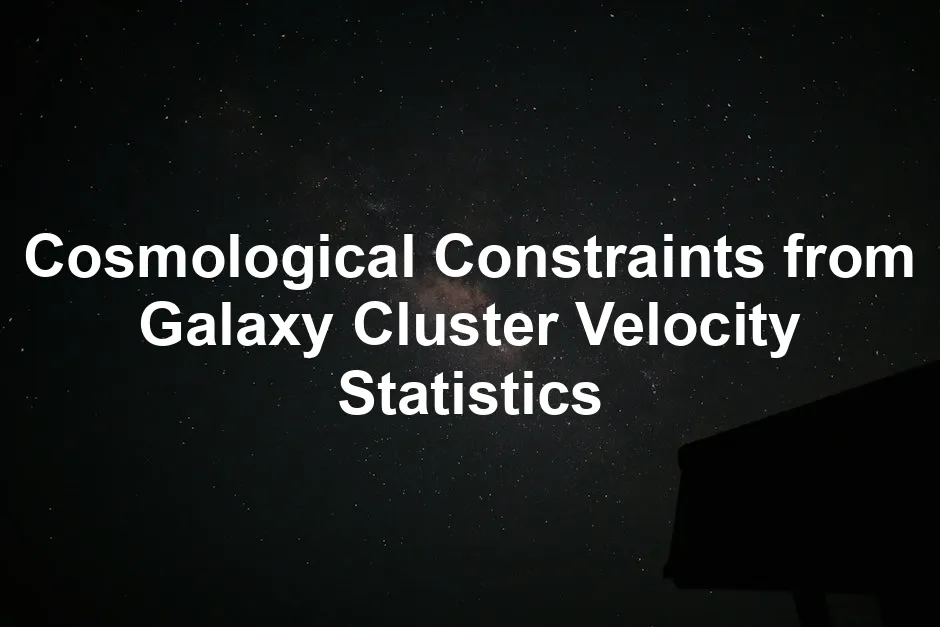Introduction
Galaxy clusters are the titans of the cosmos. They host hundreds to thousands of galaxies, all bound together by gravity. These colossal structures are not just impressive to look at; they are crucial for understanding the universe. Their dynamics provide a treasure trove of information about cosmological parameters.
When we talk about galaxy clusters, we must mention their velocity statistics. Peculiar velocities—the unexpected motions of galaxies within clusters—offer insights into the distribution of mass and the influence of dark energy. By analyzing these velocities, scientists can peel back layers of cosmic mystery.
This article aims to explore the cosmological constraints drawn from galaxy cluster velocity statistics. We will analyze how these peculiar velocities help refine our understanding of the universe’s expanding nature. The focus will be on the significance of peculiar velocities in assessing dark energy and the overarching structure of the universe.
Understanding peculiar velocities is like having a cosmic GPS. They inform us about the gravitational interactions at play and help calibrate our models. When clusters move differently than expected, it hints at the presence of unseen forces—like dark energy—affecting their motion. These velocity statistics serve as crucial indicators, guiding cosmologists toward a clearer picture of the universe’s fate.

If you’re curious to delve deeper into the universe, why not explore “Astrophysics for People in a Hurry” by Neil deGrasse Tyson? It’s a quick yet comprehensive guide that makes complex concepts accessible and entertaining!
Theoretical Background
Cosmological Models and Parameters
Lambda Cold Dark Matter (ΛCDM) Model
The ΛCDM model stands as the backbone of modern cosmology. It describes a universe composed of dark energy, cold dark matter, and ordinary matter. This model successfully explains the large-scale structure of the cosmos and its expansion. Galaxy clusters are vital components in this framework, acting as markers of the universe’s matter distribution.
Understanding how clusters behave according to the ΛCDM model allows researchers to test its validity. Observations of galaxy clusters, combined with their peculiar velocity statistics, can reveal discrepancies and refine the model itself.
Key Parameters
Several key parameters are integral to the ΛCDM model. These include:
- Matter Density (Ωm): This parameter quantifies the proportion of the universe’s total energy density that is attributed to matter.
- Hubble Constant (H0): This represents the rate of expansion of the universe today. It’s a crucial value that informs us how quickly galaxies are receding from us.
- Dark Energy Equation of State (w): This parameter characterizes the behavior of dark energy. It describes how dark energy influences the expansion rate of the universe.
Together, these parameters help cosmologists piece together the fabric of the universe, using galaxy clusters as a significant puzzle piece. Understanding their peculiar velocities adds another layer of complexity, allowing researchers to probe deeper into the fundamental nature of cosmic acceleration and structure formation.

If you want to broaden your horizons, consider reading “Cosmos” by Carl Sagan. It’s a timeless classic that beautifully intertwines science and philosophy, inviting readers to ponder the mysteries of the universe.
Galaxy Clusters and Their Dynamics
Formation of Galaxy Clusters
Galaxy clusters are the heavyweight champions of the cosmos. They form from small initial fluctuations in density that grew under gravitational attraction. Over time, these fluctuations coalesced into larger structures. Picture a cosmic game of Jenga; as pieces (galaxies) are added, the structure grows more complex. Initially, dark matter halos form, providing a scaffold for galaxies to cluster around.
Clusters evolve through mergers and interactions, gradually amassing more galaxies. As they grow, they accumulate hot gas, which emits X-rays detectable by our telescopes. This gas is crucial for understanding the cluster’s mass and dynamics. Hotter gas means higher velocities, which gives clues about the gravitational well’s depth in which these galaxies reside.
Clusters also reveal the universe’s large-scale structure and expansion history. By studying their distribution, scientists can infer the nature of dark energy and the universe’s fate. The formation of galaxy clusters is like the universe’s way of adding layers to a cosmic onion, each layer revealing more about our universe’s history.

Speaking of layers, if you enjoy exploring the universe through literature, don’t miss out on “A Brief History of Time” by Stephen Hawking. This book takes you on a journey through time and space, unraveling some of the universe’s most profound mysteries.
The Role of Peculiar Velocities
Now, let’s discuss peculiar velocities—those quirky little deviations from the expected motion of galaxies within clusters. Imagine you’re at a party; everyone is dancing to the same beat, but some folks are doing the cha-cha while others are attempting the moonwalk. This is akin to how galaxies move within clusters.
Peculiar velocities arise from gravitational interactions and the local environment. They reflect the gravitational tug-of-war between galaxies, dark matter, and the dark energy pushing the universe apart. Understanding these velocities is crucial for measuring cosmological parameters like the Hubble constant and density fluctuations.
Why do these velocities matter? They provide a direct measurement of how clusters behave, revealing insights into the mass distributions within them. By analyzing the statistical properties of peculiar velocities, astronomers can refine models of cosmic expansion. It’s like tuning a radio until you find the perfect frequency; the clearer the signal, the better our understanding of the universe’s secrets.
In essence, peculiar velocities are the cosmos’s way of signaling its deeper mysteries. They help us understand not just what we see but also what lies beyond our current grasp.

If you’re intrigued by the science behind the cosmos, check out “The Elegant Universe” by Brian Greene. It delves into string theory and the fundamental nature of reality, making complex ideas engaging and understandable.
Results
Key Findings from Previous Studies
In the realm of cosmology, the work by Bhattacharya and Kosowsky (2007) is pivotal. Their study explores the constraints on cosmological parameters derived from galaxy cluster velocity statistics. They focused on the peculiar velocities of clusters, revealing significant insights into the cosmic landscape.
Their findings highlight that future observations, particularly from microwave sky surveys, could effectively measure the kinematic Sunyaev-Zeldovich effect. This effect allows for a direct measurement of the line-of-sight peculiar velocities of galaxy clusters. The authors identified three crucial statistical quantities derived from cluster peculiar velocity catalogs: the probability density function, the mean pairwise streaming velocity, and the pairwise velocity dispersion. Each of these statistics plays a critical role in understanding the dynamics of clusters and, consequently, the universe.
Using a Fisher matrix analysis, they demonstrated that measurements with a normal error of 100 km/s could constrain the normalization of the matter power spectrum and the dark energy equation of state to better than 10 percent. Additionally, they found that the Hubble constant and the primordial power spectrum index could be constrained to a few percent, independently of other cosmological observations. This level of precision underscores the potential of galaxy cluster velocity statistics in refining our understanding of fundamental cosmological parameters.
Moreover, they reported that if cluster velocities are measured with normal errors of 300 km/s, constraints on cosmological parameters would shift, yet remain valuable. This suggests that even with higher uncertainties, the peculiar velocities of galaxy clusters are still instrumental in elucidating the structure and expansion of the universe.

If you want to dive deeper into the universe’s fundamental nature, consider reading “The Fabric of the Cosmos” by Brian Greene. It explores the nature of space and time in a way that will leave you questioning everything!
Comparison with Other Methods
When we compare the constraints derived from galaxy cluster velocities with those from cosmic microwave background (CMB) measurements and baryon acoustic oscillations (BAO), intriguing parallels emerge. Galaxy clusters, as massive structures, serve as robust tracers of the universe’s evolution. Their dynamics can reveal insights similar to those obtained from the CMB and BAO.
For instance, while CMB observations provide a snapshot of the universe’s early state, galaxy cluster velocities offer insights into its later development. Both methods yield complementary information about the universe’s expansion history and the distribution of matter. The constraints on the matter density parameter (Ωm) and the amplitude of density fluctuations (σ8) obtained from cluster studies often align well with those derived from CMB observations.
However, the galaxy cluster method has the added advantage of being less sensitive to systematic uncertainties compared to some CMB analyses. While CMB results are influenced by factors like foreground contamination and instrumental noise, cluster velocity statistics rely more on local dynamics, providing a more direct measure of structure formation.
Furthermore, studies incorporating galaxy cluster data with CMB and BAO observations yield even tighter constraints on dark energy parameters. For example, the combination of data from the South Pole Telescope (SPT) and other surveys has improved measurements of the dark energy equation of state significantly. This synergy between different observational methods enhances our understanding of the universe’s fate and the role of dark energy in cosmic expansion.
In summary, the comparison between constraints from galaxy cluster velocities and those from CMB and BAO highlights the importance of multi-faceted approaches in cosmology. By integrating data from various sources, researchers can achieve a more comprehensive picture of the universe’s composition and evolution, ultimately leading to refined models that better describe its complex nature.

If you’re fascinated by the universe’s mysteries, you might enjoy “Dark Matter and the Dinosaurs” by Lisa Randall. It presents a compelling narrative that connects cosmic events to life on Earth, offering a unique perspective on our universe.
Discussion
Implications of the Findings
Impact on Cosmological Models
The recent findings from galaxy cluster velocity statistics significantly impact our understanding of cosmological models, particularly the role of dark energy. The peculiar velocities of galaxy clusters offer a unique window into the cosmic expansion and the underlying forces shaping it.
Firstly, these velocity measurements challenge the traditional ΛCDM model, which assumes a relatively constant dark energy density influencing the universe’s expansion. The constraints derived from cluster velocities suggest that dark energy might behave differently than previously thought, possibly hinting at a dynamic nature. For instance, studies indicate that the dark energy equation of state parameter w could deviate from the -1 value expected in a cosmological constant scenario. Such deviations could imply an evolving dark energy, reshaping theories about the universe’s fate.
Moreover, the ability to constrain key parameters like the Hubble constant and matter density directly from galaxy cluster dynamics helps refine our models. When combined with observations from other cosmic surveys, these constraints provide a more cohesive view of the universe’s structure and expansion history. This synergy between different cosmological observations enhances the credibility and robustness of the ΛCDM framework while opening avenues for alternative models that accommodate the peculiarities revealed by galaxy clusters.

If you’re interested in the interplay of science and philosophy, you might want to check out “The Hidden Reality” by Brian Greene. This book delves into the multiverse theory and the concept of parallel realities, challenging our understanding of existence itself.
Future Research Directions
As we look ahead, several promising research directions emerge. Enhancing data collection methods is crucial. Upcoming surveys, such as the next-generation space telescopes and ground-based observatories, are expected to yield more precise measurements of galaxy cluster velocities. Employing advanced techniques like machine learning in data analysis could also help sift through vast datasets, identifying patterns that traditional methods might overlook.
Moreover, exploring the integration of multi-wavelength data will be vital. By combining X-ray, optical, and radio observations, researchers can create a more comprehensive picture of cluster dynamics. This holistic approach may uncover new insights into how clusters interact with dark energy and matter.
Additionally, investigating the peculiar velocities of clusters at various redshifts can help track the evolution of dark energy over time. Understanding whether dark energy has remained constant or changed throughout cosmic history could fundamentally alter our grasp of cosmology.

Limitations and Challenges
Measurement Errors
Despite the exciting potential of galaxy cluster velocity statistics, challenges abound. Measurement errors in velocity statistics pose significant hurdles. Even slight inaccuracies can ripple through calculations, affecting derived constraints. For instance, if peculiar velocities are mismeasured by a few hundred kilometers per second, the implications for dark energy parameters can be substantial. Such errors can lead to misinterpretations of the universe’s expansion history, complicating ongoing research efforts.
To address this, researchers must develop more sophisticated techniques to minimize errors. Advanced calibrations, cross-referencing with other observations, and improved statistical models are all essential strategies for enhancing measurement fidelity.
Model Assumptions
Furthermore, assumptions inherent in cosmological models can introduce biases. Many models are based on simplified scenarios that may not capture the full complexity of dark energy interactions. For example, assuming a constant dark energy density across all scales can overlook nuances like the influence of cosmic structure formation on dark energy dynamics.
It is crucial to continuously test these assumptions against observational data. Encouragingly, discrepancies between predictions and observations can lead to refinements in our models. As data collection improves, researchers can revisit and revise these assumptions, leading to a more nuanced understanding of dark energy and the universe’s expansion.
In conclusion, while galaxy cluster velocity statistics offer a promising avenue for advancing cosmological research, the path forward requires careful navigation of measurement errors and theoretical assumptions. By addressing these challenges, we can better understand the cosmic forces at play and refine our models of the universe.

Conclusion
In summary, galaxy cluster velocity statistics are a cosmic goldmine for understanding fundamental cosmological parameters. We’ve unraveled how peculiar velocities of clusters offer insights into dark energy, the structure of the universe, and the expansion rate. The work of Bhattacharya and Kosowsky (2007) and other studies underscore the potential of these statistics to refine our models of the cosmos. They demonstrate that we can constrain key parameters, such as the matter power spectrum and the dark energy equation of state, with significant precision.
The application of statistical analyses, like the Fisher matrix approach, reveals that even with moderate measurement errors, we can yield valuable constraints. As technology advances, upcoming surveys promise to enhance our ability to measure cluster velocities accurately. This means we can expect even tighter constraints on cosmological models in the near future.
The implications of these findings are profound. They not only challenge existing cosmological models but also pave the way for new theories that may better explain the mysteries of dark energy. By integrating data from various sources—such as the cosmic microwave background (CMB) and baryon acoustic oscillations (BAO)—we can develop a cohesive understanding of the universe’s evolution.
In essence, galaxy cluster velocity statistics are not just numbers; they are the keys to unlocking the secrets of the universe. As researchers continue to analyze these velocities, they will undoubtedly illuminate further cosmic truths, guiding us to a deeper comprehension of the universe’s fabric.
FAQs
What are galaxy clusters?
Galaxy clusters are large groups of galaxies bound together by gravity. They contain hundreds to thousands of galaxies, along with hot gas and dark matter. Clusters are significant in cosmology because their distribution and dynamics provide insights into the universe’s structure, evolution, and the nature of dark energy.
Why are peculiar velocities important?
Peculiar velocities—the unexpected motions of galaxies within clusters—are crucial for measuring cosmological parameters. They inform us about mass distribution within clusters and the gravitational interactions at play. By analyzing these velocities, scientists can refine estimates of the Hubble constant and gain insights into the universe’s expansion history.
How do galaxy clusters help in understanding dark energy?
Observations of galaxy clusters, particularly their velocity statistics, offer valuable constraints on dark energy. By measuring how clusters move and interact, researchers can infer the influence of dark energy on cosmic expansion. This connection is vital for understanding the universe’s fate and the role dark energy plays in its evolution.
What future surveys may enhance these studies?
Upcoming surveys, such as the European Space Agency’s Euclid mission and the Vera C. Rubin Observatory’s Legacy Survey of Space and Time (LSST), are expected to significantly improve our understanding of galaxy clusters. These surveys will provide more accurate measurements of cluster velocities and improve constraints on cosmological parameters, helping to refine our models of the universe.
Please let us know what you think about our content by leaving a comment down below!
Thank you for reading till here 🙂
If you also have a passion for stargazing, don’t forget to check out some stargazing essentials like Telescopes for Beginners and Star Maps to enhance your experience under the night sky!
The study of cosmological constraints from galaxy cluster velocity statistics is essential for understanding the dynamics of the universe.
All images from Pexels




